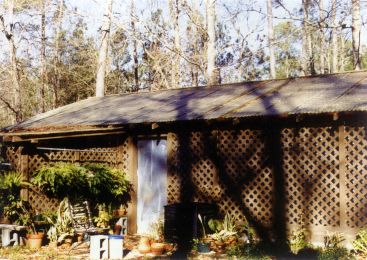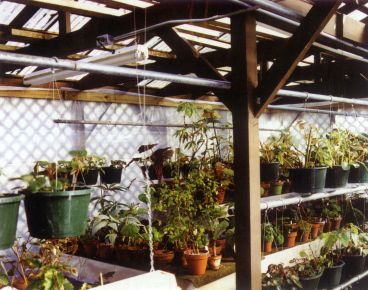I recently wrote an article for the SOS Newsletter on outside gardening in the Houston area. In reading it later, I realized that a parallel story would be about growing begonia in a shade house in south Texas. A shade house is an extremely flexible installation, capable of supplying a variety of growing conditions, so should have application to many geographic areas.
First, let me briefly describe the shade house that I built in my backyard in a three month period in the fall of 2001. The main room is 32 x 20 feet is size with 8-foot walls, peaking to 12 feet at the center. Attached is a 12 x 12 foot room for lawn equipment and supply storage. The outside walls have two feet of foundation blocks (cement) followed by a wooden structure (treated lumber) and plastic latticework. The shade house roof has about 50 percent shade from 1 x 4 inch boards forming the roof structure. Over this are corrugated PVC sheets. Inside there are numerous sheets of plastic lattice material that can increase the shade to 80 percent in selected areas, at my choice. The shade house interior is completely open except for three 4 x 4 inch posts, which support the roof. The floor starts with heavy polyethylene sheeting directly on the native soil, followed by two inches of sand, and topped off with 12 x 12 x 1 1/2 inch cement blocks or limestone gravel. The floor cement blocks are separated with small treated wood pieces (for accurate spacing) and sand for porosity. Electricity and water outlets are strategically located around the center and exterior of the shade house for my convenience.
Inside the shade house, I have three large tables 12 x 6 feet in size. One is three feet in height and the other two have fourfoot high centers and three-foot high edges. Each of these large tables occupies oneforth of the shade house and is covered with 6-mil polyethylene, then “indoor-outdoor” carpet. The overhead water system comes on once or twice a day, everyday in summer and a once a day every third or forth day in winter. This system keeps the matting constantly wet, so the plants are always surrounded by high humidity. The final forth of the shade house is my “propagation” space where I have workbenches, a computer, and 20+ large plastic terrariums for cuttings, seedlings, and some of the more sensitive plants. Steel pipe is hung throughout the shade house to hold hanging baskets. When cut back for winter, I can handle slightly over 100 hanging baskets of 10inch diameter, mostly canelike and trail ing/scandent begonia. At last count I had approximately 300 pots of 4 to 8 inch diameter placed on the tables. The plants are spaced such that the plants don’t touch. Outside, on the east and north sides of the shade house are additional metal bars for 50+ hanging baskets at full growth and shelving for about 50 large (8 to 12 inch) pots. Overall, there is space for about 500 large potted plants and more than 600 smaller pots.
Winter view of Bill’s shade house on the outside below left. The trees are bare, the weather is cold, but every plant is safely tucked away awaiting spring. Below right; the interior: hanging baskets on steel rods, plastic sheeting on walls.
Now to the actual use of the facility. One of the best examples involves growing the Rex cultivars. The Rex plants are difficult to grow at best, and I had many early failures while searching for the right growing conditions. Finally, after installing the shade house and experimenting with several combinations of conditions, I found what seemed to work fairly well. I started out with the plants in the darkest area of the shade house, subject to periodic overhead watering, and fairly far from the three fans I have installed. This was a very bad combination of conditions, and the plants did very poorly. Over the course of several months, I moved selected plants to different locations until I found the best combination.
To my surprise the rex cultivars and hose from Asia with “rhizomes at or below the surface and upright stems” all liked much more light than I initially suspected. They also like lots of air. Now I grow them in the brightest location in the shade house, probably at 40 to 50 percent shade (but no direct sunlight) with an oscillating fan constantly blowing across them. I use clay pots, not plastic, for all plants 4 inches or over. The clay pots insure the plant roots stay moist, but allow good air penetration too. The combination of periodic overhead watering, constant air movement, and high light seem to work. The wet mats below the pots also beneficially modify the ambient air temperature. In the summer, the shade house stays about 10 degrees below outside temperature. In the winter, the temperature stays about equal to outside temperature (less water evaporation hence little to-no cooling). I also modify the shade house temperature with three electric space heaters that keep minimum temperatures above 35 degree F. In this environment, rex cultivars such as B. ‘Merry Christmas” still go dormant in winter, but live to see another spring.
The real success story comes with a series of Rex begonia I obtained from Tim Anderson of Palm Hammock Orchid Estates. He has numerous outstanding rex cultivars, some of which are derived from crosses of B. deliciosa and Rexes such as B. ‘Bob Cochran’. These plants are classified as Rexes, but have the “rhizome at or below the surface with upright stems”. The environment described above, seems ideally suited for these cultivars. I feel that high light, constant air flow, and high humidity are the keys to success. I currently have plants such as B. `Flash Dance’, ‘Deco Delight’, and ‘Caribbean Clown’ as well as B. ‘Charles Jaros’, ‘Cynthia Bishop’, ‘Dale Sena’, and ‘Little Brother Montgomery’ all growing well in the shade house, through out the year.
Other begonia, species or cultivars, of any growth habit also seem to thrive in the shade house. I am especially pleased with growing the small to medium sized rhizomatous plants. The larger rhizomatous plants can successfully grow outside in the warmer months of the year, but the smaller ones need protection from the wind, rain, and small animals. This is also a great place to relax, sip a cool lemonade, and listen to bluegrass music.
Many growers consider the shade house a “poor cousin” of the greenhouse. That may be true (it certainly is much cheaper to build) but it is a very good alternate and should be considered by anyone wanting a good, effective growing environment for their begonia collection.



